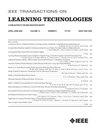机器人辅助学习在混合背景课堂中激励不同需求学生学习汉语
IF 2.9
3区 教育学
Q2 COMPUTER SCIENCE, INTERDISCIPLINARY APPLICATIONS
引用次数: 0
摘要
掌握视觉复杂的汉字对学生来说是一项巨大的挑战。在香港,不同背景的学生,包括有/没有读写困难的学生和非华语学生,被安排在同一个班级,情况更为严重。事实证明,互动设计能有效提高学生的学习成绩和参与度。然而,为背景各异的学生开发学习工具却极具挑战性。本研究针对不同背景的学生提出了机器人辅助中文学习系统(RACLS),并通过对比研究探讨了该系统对学习动机的影响。具体而言,39 名学生参加了为期五天的机器人指导培训项目,而另外 39 名学生则接受了传统的教师指导培训。对比结果表明,RACLS 可以提高有阅读障碍学生的情感参与度,加强无阅读障碍学生的行为参与度。有趣的是,实验组和对照组非华语学生的学习动机也得到了类似的提升。本文章由计算机程序翻译,如有差异,请以英文原文为准。
Motivating Students With Different Needs to Learn Chinese in a Mixed-Background Classroom by Robot-Assisted Learning
Mastering the visually complex characters of the Chinese language poses significant challenges for students. The situation is even worse in Hong Kong, where students with different backgrounds, including students with/without dyslexia and non-Chinese speaking (NCS) students, are placed in the same class. Interactive design has been proven effective in enhancing students' learning performance and engagement. However, developing a learning tool for students with diverse backgrounds is challenging. This study proposes a robot-assisted Chinese learning system (RACLS) for those with diverse backgrounds and investigates its impact on learning motivation by a comparison study. In particular, 39 students participate in a five-day robot-led training program, while another 39 students received traditional teacher-led training. The comparison results show that RACLS can enhance the emotional engagement of students with dyslexia and strengthen the behavioral engagement of students without dyslexia. Interestingly, the learning motivation of NCS students in the experimental and control groups is enhanced similarly.
求助全文
通过发布文献求助,成功后即可免费获取论文全文。
去求助
来源期刊

IEEE Transactions on Learning Technologies
COMPUTER SCIENCE, INTERDISCIPLINARY APPLICATIONS-
CiteScore
7.50
自引率
5.40%
发文量
82
审稿时长
>12 weeks
期刊介绍:
The IEEE Transactions on Learning Technologies covers all advances in learning technologies and their applications, including but not limited to the following topics: innovative online learning systems; intelligent tutors; educational games; simulation systems for education and training; collaborative learning tools; learning with mobile devices; wearable devices and interfaces for learning; personalized and adaptive learning systems; tools for formative and summative assessment; tools for learning analytics and educational data mining; ontologies for learning systems; standards and web services that support learning; authoring tools for learning materials; computer support for peer tutoring; learning via computer-mediated inquiry, field, and lab work; social learning techniques; social networks and infrastructures for learning and knowledge sharing; and creation and management of learning objects.
 求助内容:
求助内容: 应助结果提醒方式:
应助结果提醒方式:


